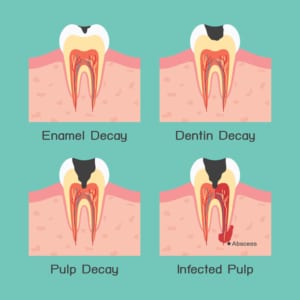 There are several different restorative options used to repair decayed teeth. However, most patients don’t really stop to think about them until they are faced with a cavity. Today, your Lone Tree dentist will explore a few of the most common treatments for tooth decay, including fillings, crowns, and root canal therapy. Metropolitan Dental Care has been providing full-service dental care for our community for over 30 years. No matter what your unique dental needs, our team can help.
There are several different restorative options used to repair decayed teeth. However, most patients don’t really stop to think about them until they are faced with a cavity. Today, your Lone Tree dentist will explore a few of the most common treatments for tooth decay, including fillings, crowns, and root canal therapy. Metropolitan Dental Care has been providing full-service dental care for our community for over 30 years. No matter what your unique dental needs, our team can help.
Dental Fillings
During the first stage of tooth decay, bacteria erode the enamel and make the teeth more vulnerable to damage. Once the enamel is breached, decay will spread. That is why it is so important to address the issue before it worsens. Small cavities can usually be treated with a dental filling. In years past, the only fillings available were amalgam – a mixture of tin, copper, silver, zinc, and mercury. At Metropolitan Dental Care, we offer tooth-colored composite fillings for a natural look that will blend in with your smile. A dental filling can be placed in a single office visit.
Dental Crowns
Cavities that are too large for a filling can often be repaired with a dental crown. Made from zirconia, ceramic, or another high-quality material, a crown is designed to slip over the entire tooth structure, giving additional support and reinforcement. In most cases, receiving a dental crown takes two office visits. During the first, your Lone Tree dentist will prepare the tooth by removing a thin layer of enamel. Next, impressions will be taken so that our lab can fabricate your restoration. Once it is completed, the crown will be placed during a second visit at our office.
Root Canal Therapy
If decay or dental damage reaches the pulp of the tooth, root canal therapy must be performed in order to save it. This process involves removing all infection and living tissues – the nerves and blood vessels – from inside the tooth. Next, the surfaces will be scrubbed clean and disinfected, and the root canals and pulp chamber will be filled. In most cases, a dental crown is also added for strength and reinforcement. Contrary to popular belief, there is minimal discomfort associated with root canal therapy. In fact, because the source of infection is removed during the procedure, most patients experience significant relief following the treatment.
Tooth Extraction
As dental professionals, we believe it is always better to save a natural tooth when possible. Unfortunately, there are cases when this simply isn’t feasible. For example, if decay is too extensive, restorative treatments would not be predictable. On the other hand, if left untreated, the bacteria and infection could spread to other teeth, seriously compromising your oral health. Therefore, a tooth extraction may be necessary in cases of severe decay.
Exploring Replacement Options
If a tooth must be removed, we almost always recommend replacing it, with the exception of third molars (wisdom teeth). Doing so is important to several reasons. First, replacing a missing tooth can restore your bite function and prevent shifting of the adjacent teeth. It also helps balance the pressure across your bite, preventing damage from excessive force. There are several replacement options available, including traditional bridges and dental implants. Your Lone Tree dentist can help you determine which treatment option will most effectively meet your needs.
Contact Your Lone Tree Dentist to Learn More
If you have a cavity, treating it sooner rather than later can help save you time and money, and help you avoid extensive treatments down the road. Metropolitan Dental Care is proud to serve Denver and Lone Tree as well as the surrounding communities of Parker, Centennial, and Highlands Ranch. To learn more, contact your Lone Tree dentist by calling 303-534-2626 to schedule an appointment.

